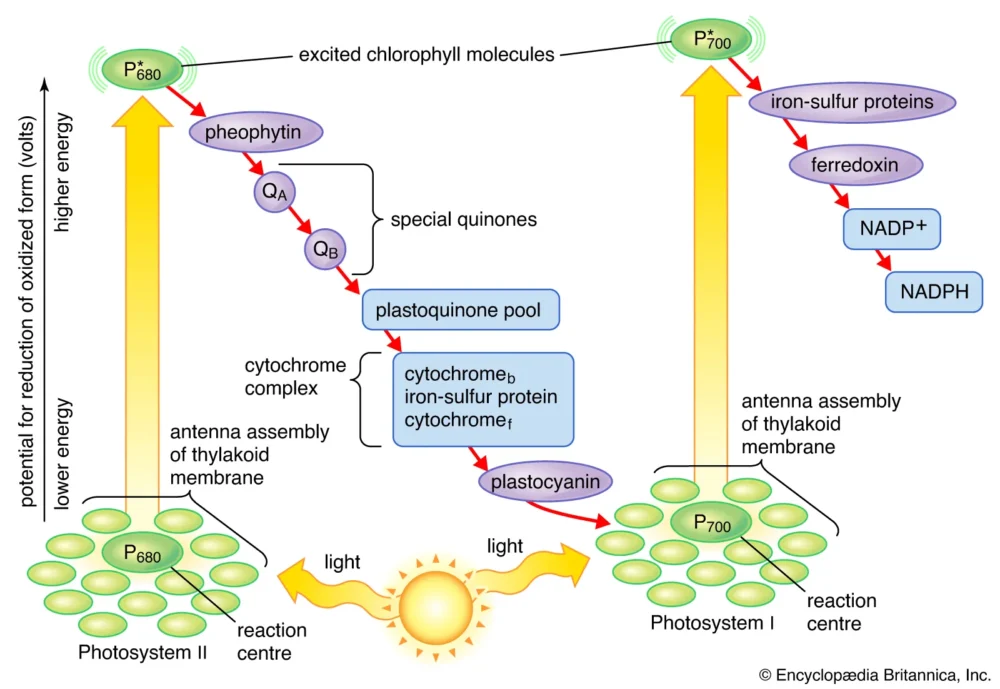Light Reaction Definition
The light reaction is a crucial step in photosynthesis, where solar energy is transformed into chemical energy, specifically in the form of NADPH and ATP.
Read More: What is Photosynthesis in Biology Short Answer with Explanation
What is Light Reaction?
The light reaction, also known as the photolysis reaction, occurs in the presence of light, typically within the grana of chloroplasts.
Within the photosystems, there are pigment molecules. In plants, chlorophyll serves as a primary pigment actively participating in light reactions such as photosynthesis.
Additional pigments, like carotenoids, also play a role. Chlorophyll, located in the thylakoid membrane of chloroplasts, absorbs sunlight energy.
This energy is then transferred to ATP and NADPH through two electron transport chains. The process utilizes water and results in the release of oxygen.
Now, let’s delve into an overview of the light reaction and the mechanisms it involves.
Diagram of light reaction of photosynthesis

Read More: Photosynthesis Formula Equation with Lots of Key Facts
Steps Involved in Light Reaction of Photosynthesis
The initial phase of the photosynthesis process is the light reaction, where solar energy is converted into chemical energy in the form of ATP and NADPH. This transformation is facilitated by protein complexes and pigment molecules.
Here is an explanation of the light reaction process:
- Absorption of Sunlight Energy: Chlorophyll, the pigment responsible for absorbing light, captures energy from sunlight and converts it into chemical energy in the form of electron carriers like NADPH and ATP.
- Utilization of Light Energy: Both Photosystems I and II, located within the thylakoid membranes of chloroplasts, employ light energy.
- Formation of Carbohydrate Molecules: Chemical energy obtained during the reactions is used to derive carbohydrate molecules from carbon dioxide.
- Electron Movement: Light energy causes water to split, extracting electrons from Photosystem II. These electrons travel from PSII to b6f (cytochrome), then to Photosystem I (PSI), reducing into energy.
- Re-energizing Electrons: Electrons of high energy are re-energized in Photosystem I and use this energy to reduce NADP+ into NADPH.
- Non-cyclic Photophosphorylation: Cytochrome, using electron energy from Photosystem II, pumps hydrogen ions from the lumen to the stroma. This energy allows ATP synthase to bind to ADP, forming ATP.
- Cyclic Photophosphorylation: Cytochrome b6f uses electron energy from both Photosystems I and II to generate ATP, while NADPH production is halted to maintain the right balance of ATP and NADPH.
In summary, light reactions harness light energy to drive electron transport and proton pumping, converting light energy into the biologically useful forms of ATP and NADPH. This process provides a usable source of reducing power in the form of NADPH.
Short Questions on Light Reaction of Photosynthesis
Q1. What is the light reaction of photosynthesis?
The light reaction of photosynthesis is the first stage of photosynthesis, in which light energy is captured by chlorophyll and converted into chemical energy in the form of ATP and NADPH. These energy-rich molecules are then used in the Calvin cycle to fix carbon dioxide into organic molecules, such as glucose.
Q2. Where does the light reaction of photosynthesis take place?
The light reaction takes place in the thylakoids, which are membranous sacs found within the chloroplasts of plant cells.
Q3. What are the products of the light reaction of photosynthesis?
The two main products of the light reaction are:
- ATP (adenosine triphosphate): The energy currency of the cell. ATP is used to power many cellular processes, including the Calvin cycle.
- NADPH (nicotinamide adenine dinucleotide phosphate): An electron carrier that provides the energy for the Calvin cycle to fix carbon dioxide.
Q4. What are the steps of the light reaction of photosynthesis?
The light reaction can be summarized in the following steps:
- Light absorption: Chlorophyll molecules in the photosystems absorb light energy.
- Electron transport: The excited electrons are transferred through a series of electron carriers in the thylakoid membrane.
- Proton gradient: The electron transport chain pumps protons (H+) across the membrane, creating a proton gradient.
- ATP synthesis: ATP synthase uses the energy of the proton gradient to produce ATP from ADP and Pi.
- NADPH production: In PSI, the electrons lost from chlorophyll are replaced by electrons from water. This process splits water molecules, releasing oxygen as a byproduct. The electrons from water are then transferred to NADP+, forming NADPH.
Q5. How is the light reaction linked to the Calvin cycle?
The ATP and NADPH produced in the light reaction provide the energy and reducing power needed for the Calvin cycle to fix carbon dioxide into organic molecules.
Q6. What are some of the key terms related to the light reaction of photosynthesis?
- Chlorophyll
- Photosystem
- Electron transport chain
- Proton gradient
- ATP synthase
- NADPH
- Calvin cycle
Explore All Post Related to Photosynthesis
Latest post on Biology:

